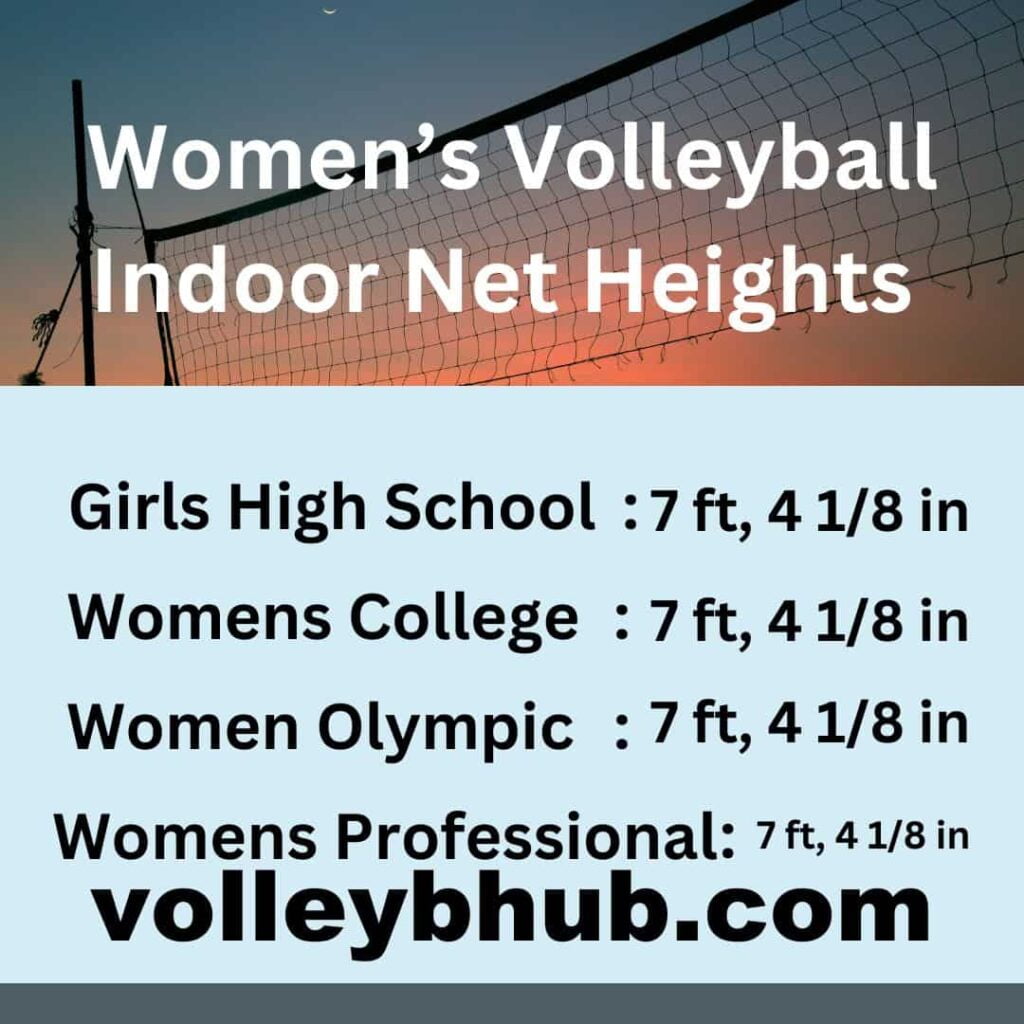
Understanding Volleyball Net Heights
Volleyball is a popular sport that combines athleticism, strategy, and teamwork. Millions of people across the globe enjoy it, but not everyone is aware of the significance of the volleyball net height in the game.
One of the key factors that make the sport fair and enjoyable is adjusting the net height based on the players’ age, skill level, and gender. In this guide, we’ll break down the varying net heights for different groups, such as men, women, youth, and both indoor and outdoor volleyball.
Why Net Height Differs Between Men and Women
The volleyball net height differs between men and women to account for the differences in average height and physical abilities. For women, the net is set slightly lower to ensure that the game remains competitive, fair, and enjoyable.
While men’s volleyball nets are set at 2.43 meters (7 feet 11 5/8 inches), the height for women is 2.24 meters (7 feet 4 1/8 inches). This variation allows both genders to compete with an equal level of challenge.
Adjusting Net Heights for Inclusivity
Another important factor in volleyball is making the sport accessible to a wide range of people. If we consider adjusting the net height for other groups, such as youth or individuals with varying skill levels, we can make the game more inclusive.
For example, youth volleyball nets are typically set at 2.13 meters for younger players to accommodate their height and skill development. Beach volleyball and indoor volleyball also have their own regulations for net heights, making it important to know the specific requirements for each type of play.
Categories and Their Standard Net Heights
- Men’s volleyball: 2.43 meters (7 feet 11 5/8 inches)
- Women’s volleyball: 2.24 meters (7 feet 4 1/8 inches)
- Youth volleyball: 2.13 meters for younger players
- Beach volleyball: Typically set lower than indoor volleyball to accommodate the outdoor conditions and different playing surfaces.
By understanding and adapting to the correct net height, players can enjoy the game at any level of play while maintaining fairness and competitiveness. Whether you’re new to the sport or a seasoned player, knowing the regulations for net height is key to enhancing your volleyball experience.
With these adjustments, we can continue to attract and retain a diverse group of players in the world of volleyball.
Women’s Volleyball Net Height
In volleyball, the height of the net is a crucial factor that influences gameplay. For women’s volleyball, the standard net height is set at 7 feet, 4 1/8 inches. However, this height can vary depending on the player’s age and the level of competition. Understanding these adjustments ensures that the game remains competitive and enjoyable for players of all ages and abilities.
Age-Based Net Height Adjustments for Women
Girls typically start playing with the standard 7 feet, 4 1/8 inches volleyball net height by the time they reach 15 years old. This height is maintained throughout their playing career until they turn 45. After 45 years of age, the net is lowered slightly to 7 feet, 2 1/8 inches.
Once women reach the age of 60, the net height is further reduced to 7 feet to accommodate the physical changes that may come with aging. These adjustments are standard in club volleyball and allow women to continue enjoying the sport while maintaining a fair level of competition.
Improving Performance at the Net
While improving your vertical jump is essential for success at the net, it’s not the only way to enhance your gameplay. Working on your agility is another critical aspect that can give you an edge when facing blockers. Agility helps you move quickly and efficiently, which is key to outmaneuvering the defense and executing successful plays.
In addition, perfecting the timing of your hitting sets can drastically improve your offensive efficiency. Common hitting sets like one balls or slides are frequently used but often not fully mastered.
Developing a strong connection with your setter and focusing on increasing the speed of your sets will result in a faster and more effective offense. This not only leads to better teamwork but also makes it more difficult for the opposing team to react defensively.

Women’s Beach Volleyball Net Height
In women’s beach volleyball, net height is a key element that varies depending on the player’s age. Similar to the structure for men, the net height adjusts as players grow and develop their skills. Understanding these changes helps players transition smoothly between age categories and improves their overall gameplay.
Net Height Progression Based on Age
For girls 12 and under, the net height is set at 6 feet, 6 3/4 inches (2.00 meters). As players move to the 13-14 age group, the net height increases to 7 feet (2.13 meters). Once girls reach 15 years old, the net height rises to the standard 7 feet, 4 1/4 inches (2.43 meters), which remains the height used in women’s beach volleyball from then on.
This gradual increase ensures that players develop the necessary skills and physical abilities before competing at the highest level.
Interestingly, girls begin playing at their maximum net height at age 15, while boys generally don’t reach their max net height until around ages 16-17. This earlier transition helps girls prepare for more competitive play sooner, allowing them to focus on refining their techniques.

Preparing for Beach Volleyball Net Height Changes
As players advance to higher net heights, mastering ball control becomes essential. The most successful players aren’t always the tallest or strongest, but rather those who have the best accuracy and control over the ball.
For instance, learning how to effectively hit a deep roll shot to the far corner of the court can significantly improve your gameplay. This type of shot is especially valuable in beach volleyball, where strategic placement often outperforms sheer power.
Improving Your Skills Despite Physical Differences
One of the key lessons in women’s beach volleyball is that physical size does not always determine skill level. With proper training and study of the game, players can overcome any physical disadvantages.
Observing the techniques of top players, particularly their use of control and strategic hitting, can provide valuable insights into how to improve your own performance.
Read Also: 6-2 Volleyball Rotation
Understanding Youth Volleyball Net Heights
Youth volleyball is an exciting and competitive sport, with organizations like USAV (USA Volleyball) leading the way in hosting national championships for players aged 12-18 across the United States.
Competing in these events requires a solid understanding of the game’s rules, one of which is the volleyball net height, which varies by age and gender.
Volleyball Net Heights by Age Group
For players 10 years old and younger, the net height for girls is set at 6 feet, 6 inches (1.98 meters), while for boys, it is 7 feet (2.13 meters). As players develop their skills, the net height increases accordingly.
At ages 11-12, the net height rises to 7 feet (2.13 meters) for both girls and boys. This gradual increase ensures that young players can adapt to the game and grow their abilities as they progress.
When players reach the 13-14 age group, the net height becomes 7 feet, 4 1/8 inches (2.24 meters) for both boys and girls. This height stays the same for girls beyond this age group, allowing them to continue developing at a competitive level.
For boys aged 15 and older, the net height is increased to 7 feet, 11 5/8 inches (2.43 meters), which is the official height used in adult men’s volleyball. This final adjustment prepares young male athletes for higher levels of competition.
Importance of Knowing the Net Height
Understanding the different net heights is essential for players, coaches, and parents alike. Knowing the correct height ensures that athletes are practicing in the right environment, which is crucial for improving their skills and becoming more competitive.
This knowledge also helps ensure fair play during matches, as players will be competing under the same regulations.
Girls’ Indoor Volleyball Net Height
In girls’ indoor volleyball, the net height plays a significant role in shaping a player’s skills and competitive edge. Unlike boys, where the net height increases as they grow older, girls reach their final net height earlier.
At 13 years old, the official net height for girls is set at 7 feet, 4 1/8 inches (2.24 meters), which remains consistent throughout their playing careers unless specific clubs opt for lower nets for older players.
Early Adaptation to Standard Net Height
While girls under the age of 13 may compete on a lower net, it’s beneficial for them to start practicing on the standard 7 feet, 4 1/8 inches net height as early as possible.
Early exposure to the standard height helps ease the transition into higher levels of play, providing a competitive advantage. Getting familiar with the official net height early on can give players the confidence and experience they need to excel in future games.
Why Net Height Matters in Girls’ Volleyball
Playing on the correct net height is crucial for skill development. It ensures that players are competing under the same conditions as in professional or club-level volleyball. Mastering techniques such as serving, blocking, and spiking at the official height helps players develop the strength and accuracy required for higher levels of competition.

FAQ’s: Women’s Volleyball Net Height
What distinguishes the volleyball net height for men and women?
The net height in volleyball varies by gender. For men, the net stands at 7 feet, 11 5/8 inches (2.43 meters), whereas for women, it is set at 7 feet, 4 1/8 inches (2.24 meters). These measurements are consistent across both indoor and beach volleyball to accommodate the physical differences between genders.
Is the net lower for women’s volleyball?
Yes, the volleyball net height for women is lower than men’s. It is set at 7 feet, 4 1/8 inches (2.24 meters), while the men’s net is 7 feet, 11 5/8 inches (2.43 meters).
Does height matter in volleyball?
Height can be an advantage in volleyball, especially for attacking and blocking. However, skills like ball control, defense, and passing are equally crucial for success, meaning that shorter players can still excel with strong technique and agility.




